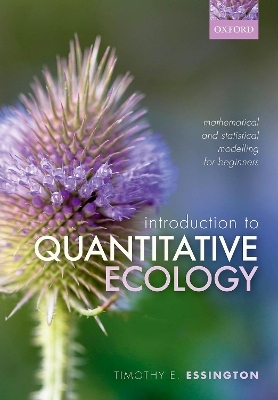
Introduction to Quantitative Ecology
Oxford University Press (Verlag)
978-0-19-284348-7 (ISBN)
Environmental science (ecology, conservation, and resource management) is an increasingly quantitative field. A well-trained ecologist now needs to evaluate evidence generated from complex quantitative methods, and to apply these methods in their own research. Yet the existing books and academic coursework are not adequately serving most of the potential audience - instead they cater to the specialists who wish to focus on either mathematical or statistical aspects, and overwhelmingly appeal to those who already have confidence in their quantitative skills. At the same time, many texts lack an explicit emphasis on the epistemology of quantitative techniques. That is, how do we gain understanding about the real world from models that are so vastly simplified?
This accessible textbook introduces quantitative ecology in a manner that aims to confront these limitations and thereby appeal to a far wider audience. It presents material in an informal, approachable, and encouraging manner that welcomes readers with any degree of confidence and prior training. It covers foundational topics in both mathematical and statistical ecology before describing how to implement these concepts to choose, use, and analyse models, providing guidance and worked examples in both spreadsheet format and R. The emphasis throughout is on the skilful interpretation of models to answer questions about the natural world.
Introduction to Quantitative Ecology is suitable for advanced undergraduate students and incoming graduate students, seeking to strengthen their understanding of quantitative methods and to apply them successfully to real world ecology, conservation, and resource management scenarios.
Timothy E. Essington is a Professor at the School of Aquatic and Fishery Sciences, University of Washington, USA. He is also Director of the Center for Quantitative Sciences and of the University of Washington's QERM Graduate Program. His research chiefly focuses on food web interactions involving fish in marine, estuarine and freshwater habitats.
About This Book
Part I: Fundamentals of Dynamic Models
1: Why Do We Model?
2: Introduction to Population Models
3: Structured Population Models
4: Competition and Predation Models
5: Stochastic Population Models
Part II: Fitting Models to Data
6: Why Fit Models to Data?
7: Random Variables and Probability
8: Likelihood and Its Applications
10: Model Selection
10: Bayesian Statistics
Part III: Skills
11: Mathematics Refresher
12: Modeling in Spreadsheets
13: Modeling in R
14: Skills for Dynamic Models
15: Sensitivity Analysis
16: Skills for Fitting Models to Data
Part IV: Putting It All Together and Next Steps
17: Putting It Together : Fitting a Dynamic Model
18: Next Steps
| Erscheinungsdatum | 06.12.2021 |
|---|---|
| Zusatzinfo | 87 colour line figures/illustrations and 32 tables |
| Verlagsort | Oxford |
| Sprache | englisch |
| Maße | 170 x 245 mm |
| Gewicht | 608 g |
| Themenwelt | Mathematik / Informatik ► Mathematik ► Angewandte Mathematik |
| Naturwissenschaften ► Biologie ► Ökologie / Naturschutz | |
| ISBN-10 | 0-19-284348-6 / 0192843486 |
| ISBN-13 | 978-0-19-284348-7 / 9780192843487 |
| Zustand | Neuware |
| Informationen gemäß Produktsicherheitsverordnung (GPSR) | |
| Haben Sie eine Frage zum Produkt? |
aus dem Bereich


